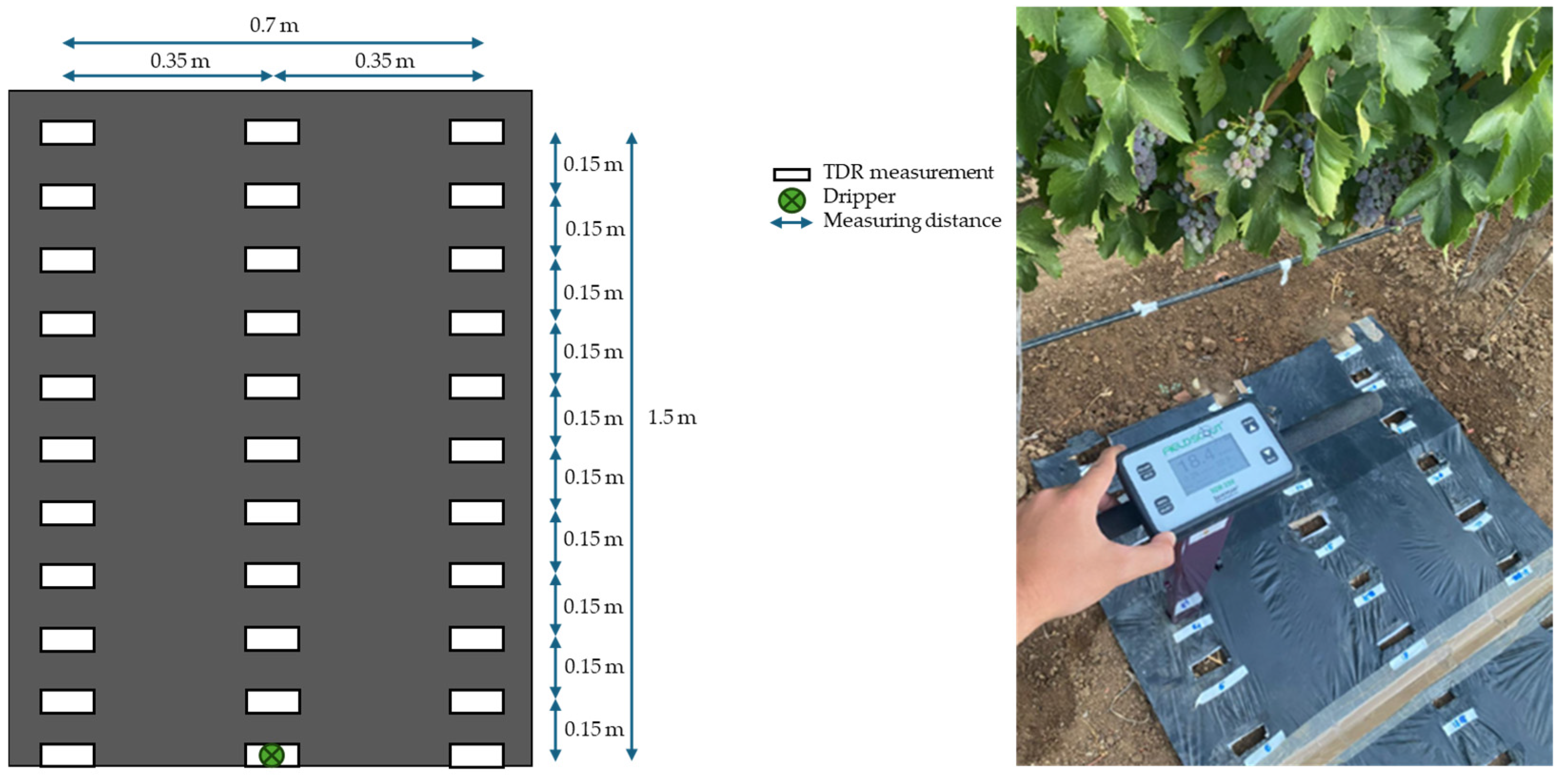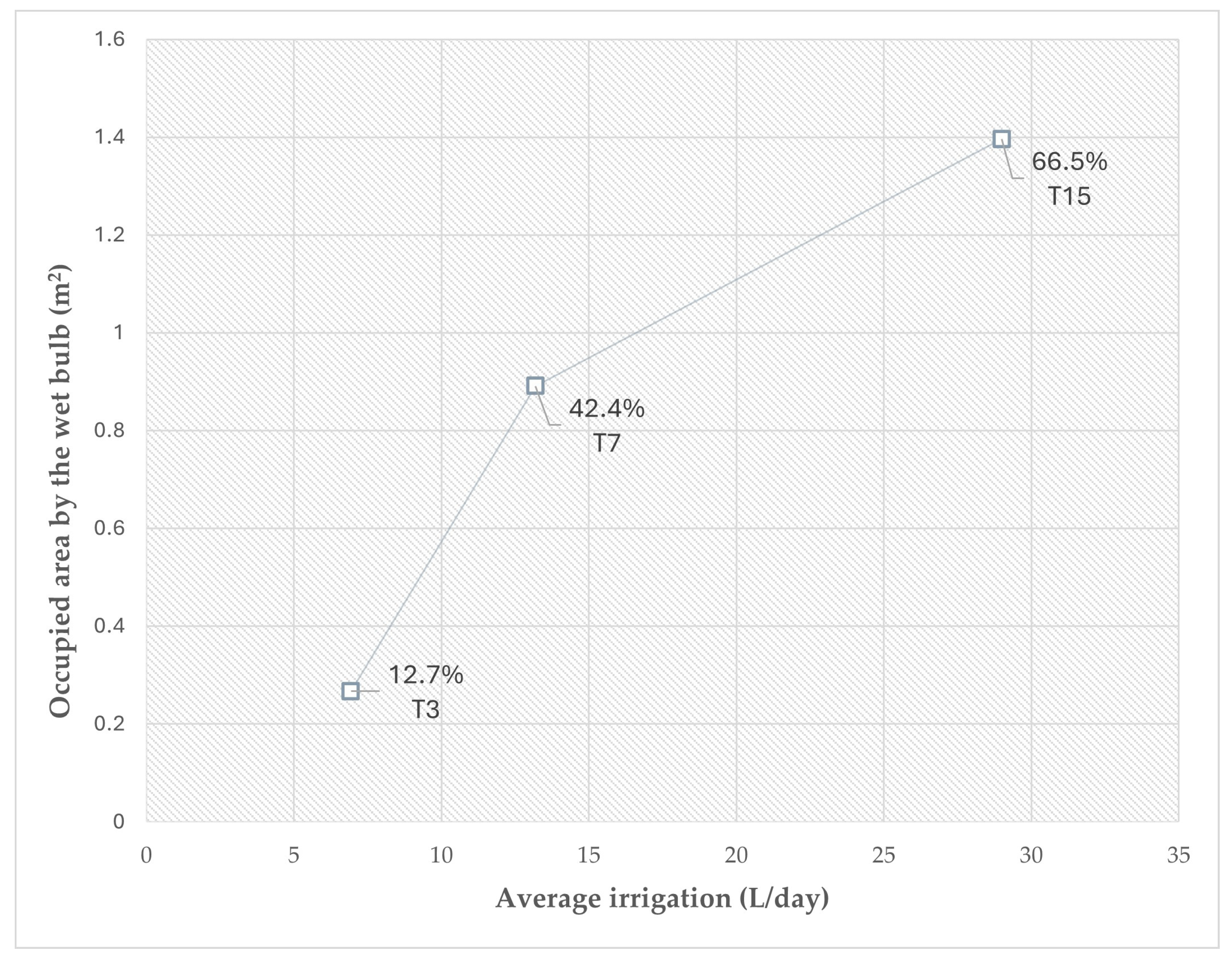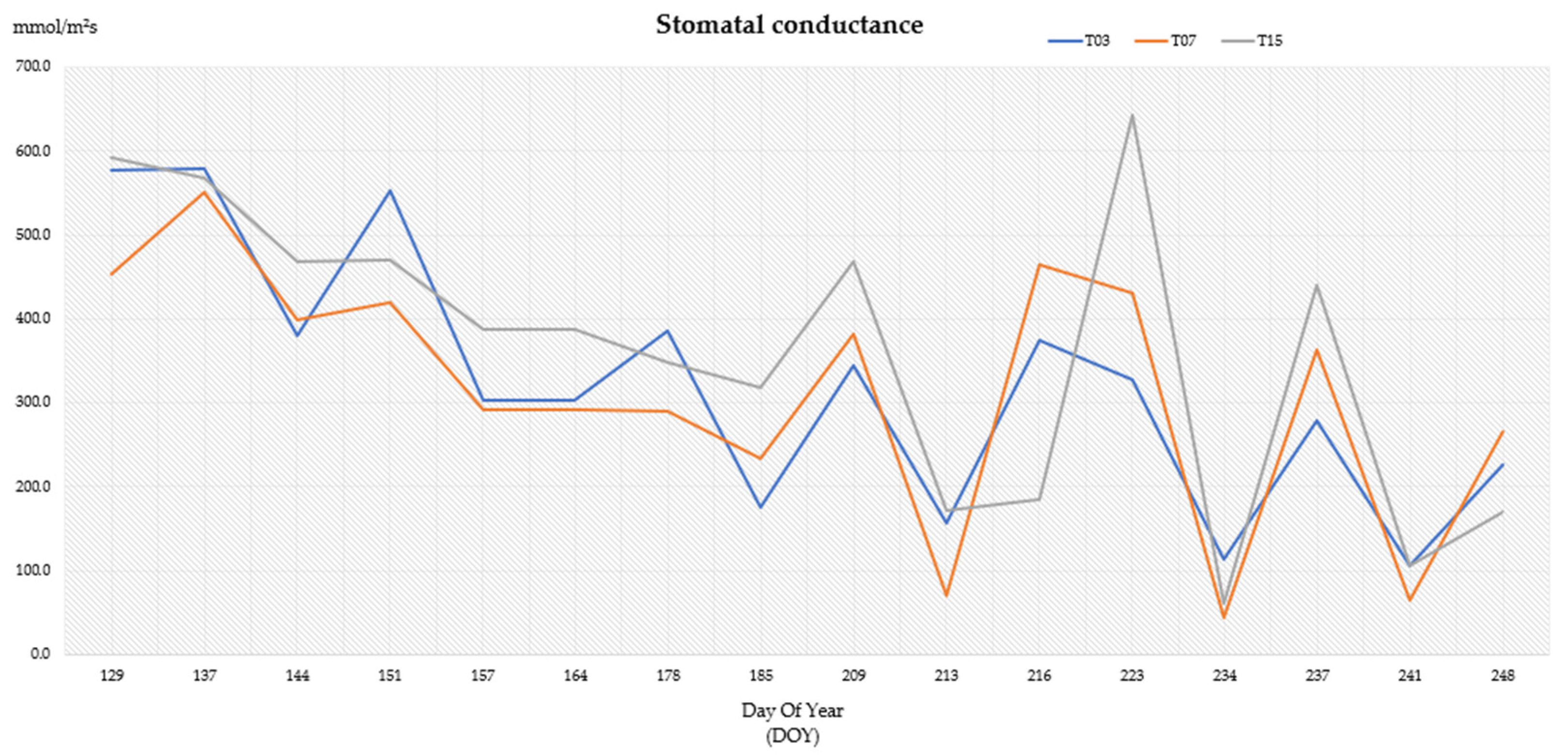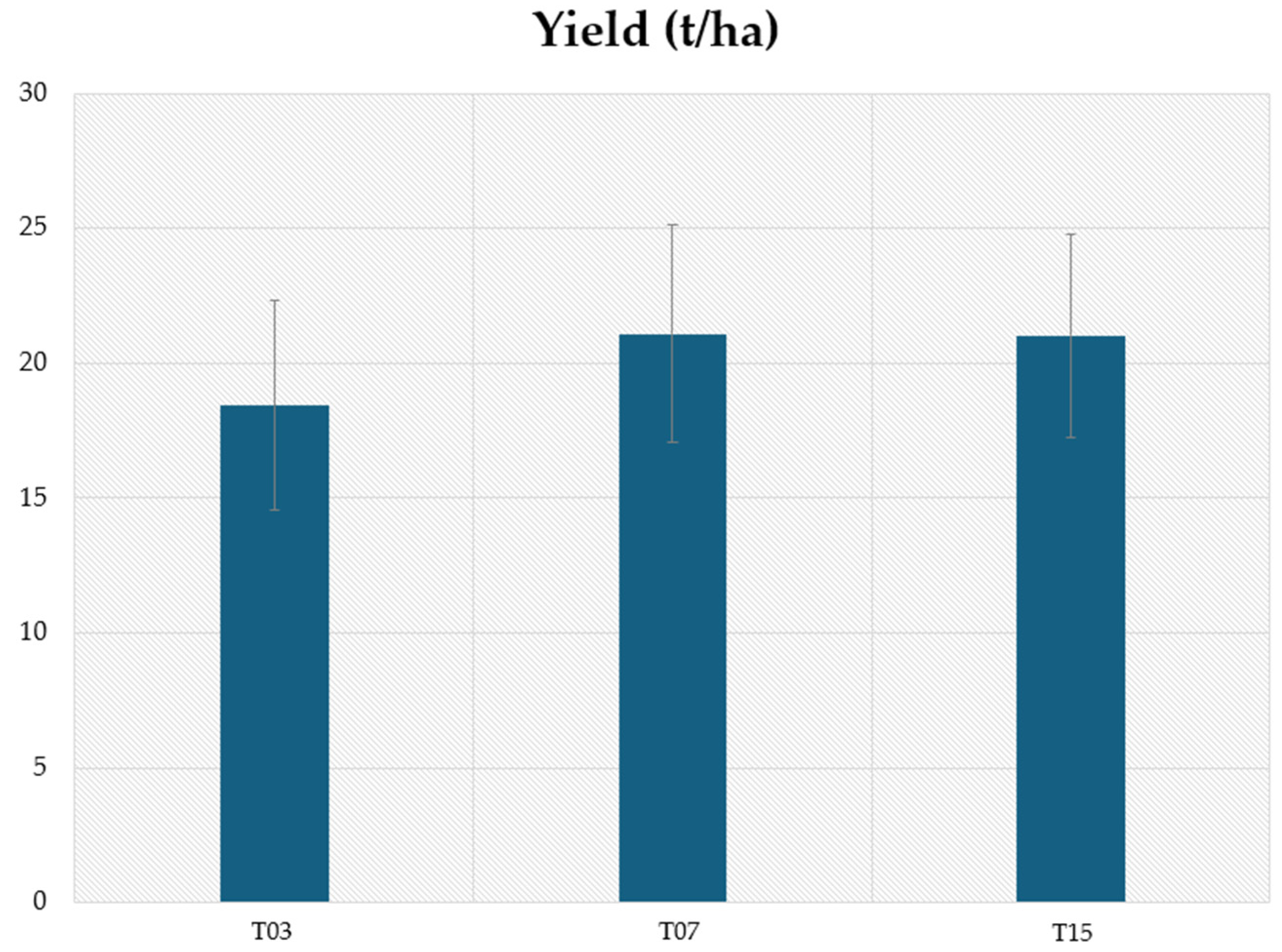Assessing Effect of Irrigation Frequency on Evaporation and Transpiration in Vineyards Using SIMDualKc Simulation Model with Measured Wet Fraction
Abstract
:1. Introduction
2. Materials and Methods
2.1. Description of the Trial
2.2. Measurements of the Soil Wetted Fraction (wf)
2.3. Estimation of Evaporation and Transpiration
- Soil: The total available water (TAW) (mm/m) was introduced directly in SIMDualKc according to the values established by FAO56 [19] depending on the textures of the three layers (0–0.30 m, 0.30–0.60 m, 0.60–0.90 m) (Table 2). Total evaporable water (TEW) (mm/m) and readily evaporable water (REW) (mm/m) were also introduced in SIMDualKc according to the values established by FAO56 [19] as a function of soil texture at the 0.10 m depth. The absence of vegetation cover between rows on the plot was indicated.
- Climate: The precipitation (mm), ETo calculated according to the Penman–Monteith method (mm), minimum daily relative humidity (mm), average daily wind speed (m/s), latitude (m), altitude (m), and anemometer height (m) of a nearby meteorological station (distance less than 1 km) were entered.
- Crop: To evaluate crop development, the growth stages according to FAO56 were determined through weekly phenological monitoring. The depth of the root (m) was measured in the pit made to determine the characteristics of the soil, as well as the height of the plant (m), employing a telescopic measuring rod. The p-fraction value was taken from the reference value set by FAO56 for the cultivation of vines and their varieties for wine production. To adjust the fraction of crop cover in the model, the LAI value was measured four times during the growing season with an LAI-2200 plant canopy analyzer (LI-COR Inc., Lincoln, NE, USA) on two vines per experimental plot (eight vines per treatment), in accordance with [36]. To evaluate the Kcb, the stomatal sensitivity function (Fr) value was used with an adjustment relative to stomatal control applied as a function of water stress measured by the leaf water potential at solar noon with a Scholander-type pressure chamber (Soil Moisture Corp., Model 3500, Santa Barbara, CA, USA).
- Irrigation: Through the programming option chosen by the user, three irrigation schedules were established throughout the campaign in which the same volume of water, corresponding to 30% of the ETo, was applied but distributed in different frequencies (T03, T07, and T15). That is, the volume of water applied in each irrigation and the time between irrigations varied between the different irrigation schedules. However, overall, the total amount of water applied was the same (Table 1). This SIMDualKc simulation model establishes by default that if the irrigation is by drip, the wf of the irrigation is 0.4 (40%). However, in this study, as this depended on each irrigation treatment, the actual value observed in the field for T03, T07, and T15 was introduced.
2.4. Yield Evaluation
3. Results and Discussion
3.1. Wetted Fraction (wf) of the Soil from the Different Treatments with the TDR Sensor
3.2. Estimation of Evaporation and Transpiration of Each Treatment with the SIMDualKc Model
3.3. Analysis of the Yield of Each Treatment
4. Conclusions
Author Contributions
Funding
Data Availability Statement
Conflicts of Interest
References
- Mirás-Avalos, J.; Araujo, E. Optimization of Vineyard Water Management: Challenges, Strategies, and Perspectives. Water 2021, 13, 746. [Google Scholar] [CrossRef]
- Medrano, H.; Tomás, M.; Martorell, S.; Escalona, J.-M.; Pou, A.; Fuentes, S.; Flexas, J.; Bota, J. Improving Water Use Efficiency of Vineyards in Semi-Arid Regions. A Review. Agron. Sustain. Dev. 2015, 35, 499–517. [Google Scholar] [CrossRef]
- Van Leeuwen, C.; Roby, J.; De Rességuier, L. Soil-Related Terroir Factors: A Review. OENO One 2018, 52, 173–188. [Google Scholar] [CrossRef]
- Romero, P.; Navarro, J.M.; Ordaz, P.B. Towards a Sustainable Viticulture: The Combination of Deficit Irrigation Strategies and Agroecological Practices in Mediterranean Vineyards. A Review and Update. Agric. Water Manag. 2022, 259, 107216. [Google Scholar] [CrossRef]
- Mancha, L.A.; Uriarte, D.; Valdés, E.; Moreno, D.; Prieto, M.d.H. Effects of Regulated Deficit Irrigation and Early Cluster Thinning on Production and Quality Parameters in a Vineyard Cv. Tempranillo under Semi-Arid Conditions in Southwestern Spain. Agronomy 2020, 11, 34. [Google Scholar] [CrossRef]
- Bouzas-Cid, Y.; Falqué, E.; Orriols, I.; Mirás-Avalos, J.M. Effects of Irrigation over Three Years on the Amino Acid Composition of Treixadura (Vitis vinifera L.) Musts and Wines, and on the Aromatic Composition and Sensory Profiles of Its Wines. Food Chem. 2018, 240, 707–716. [Google Scholar] [CrossRef] [PubMed]
- Balint, G.; Reynolds, A.G. Irrigation Level and Time of Imposition Impact Vine Physiology, Yield Components, Fruit Composition and Wine Quality of Ontario Chardonnay. Sci. Hortic. 2017, 214, 252–272. [Google Scholar] [CrossRef]
- Romero, P.; García García, J.; Fernández-Fernández, J.I.; Muñoz, R.G.; del Amor Saavedra, F.; Martínez-Cutillas, A. Improving Berry and Wine Quality Attributes and Vineyard Economic Efficiency by Long-Term Deficit Irrigation Practices under Semiarid Conditions. Sci. Hortic. 2016, 203, 69–85. [Google Scholar] [CrossRef]
- Intrigliolo, D.S.; Pérez, D.; Risco, D.; Yeves, A.; Castel, J.R. Yield Components and Grape Composition Responses to Seasonal Water Deficits in Tempranillo Grapevines. Irrig. Sci. 2012, 30, 339–349. [Google Scholar] [CrossRef]
- Ferreira, M.I.; Silvestre, J.; Conceição, N.; Malheiro, A.C. Crop and Stress Coefficients in Rainfed and Deficit Irrigation Vineyards Using Sap Flow Techniques. Irrig. Sci. 2012, 30, 433–447. [Google Scholar] [CrossRef]
- Santesteban, L.G.; Miranda, C.; Royo, J.B. Regulated Deficit Irrigation Effects on Growth, Yield, Grape Quality and Individual Anthocyanin Composition in Vitis vinifera L. Cv. ‘Tempranillo’. Agric. Water Manag. 2011, 98, 1171–1179. [Google Scholar] [CrossRef]
- Lavado, N.; Prieto, M.H.; Mancha, L.A.; Moreno, D.; Valdés, M.E.; Uriarte, D. Combined Effect of Crop Forcing and Reduced Irrigation as Techniques to Delay the Ripening and Improve the Quality of Cv. Tempranillo (Vitis vinifera L.) Berries in Semi-Arid Climate Conditions. Agric. Water Manag. 2023, 288, 108469. [Google Scholar] [CrossRef]
- Freeman, B.M.; Blackwell, J.; Garzoli, K. V Irrigation Frequency and Total Water Application with Trickle and Furrow Systems. Agric. Water Manag. 1976, 1, 21–31. [Google Scholar] [CrossRef]
- Montoro, A.; Mañas, F.; López-Urrea, R. Transpiration and Evaporation of Grapevine, Two Components Related to Irrigation Strategy. Agric. Water Manag. 2016, 177, 193–200. [Google Scholar] [CrossRef]
- Scholasch, T. Improving Winegrowing with Sap Flow Driven Irrigation—A 10-Year Review. Acta Hortic. 2018, 1222, 155–168. [Google Scholar] [CrossRef]
- Esteban-Sanchez, G.; Campillo, C.; Uriarte, D.; Moral, F.J. Technical Feasibility Analysis of Advanced Monitoring with a Thermal Camera on an Unmanned Aerial Vehicle and Pressure Chamber for Water Status in Vineyards. Horticulturae 2024, 10, 305. [Google Scholar] [CrossRef]
- Sebastián, B.; Baeza, P.; Santesteban, L.G.; Sánchez de Iguel, P.; De La Fuente, M.; Lissarrague, J.R. Response of Grapevine Cv. Syrah to Irrigation Frequency and Water Distribution Pattern in a Clay Soil. Agric. Water Manag. 2015, 148, 269–279. [Google Scholar] [CrossRef]
- Yuste, J.; Montoro, A.; Cancela, J.J.; Martínez-Porro, D.; Mancha, L.A.; Moreno, D.; Torija, I.; Rodríguez-Febereiro, M.; Vilanova, M.; Uriarte, D. Irrigation Frequency in Red Varieties: Impact on Grape Production and Composition, during a Biennial Period, in 4 Regions of Spain. BIO Web Conf. 2023, 68, 01004. [Google Scholar] [CrossRef]
- Allen, R.G.; Pereira, L.S.; Raes, D. Crop Evapotranspiration-Guidelines for Computing Crop Water Requirements-FAO Irrigation and Drainage Paper 56. FAO 1998, 300, D05109. [Google Scholar]
- Rallo, G.; Paço, T.A.; Paredes, P.; Puig-Sirera, À.; Massai, R.; Provenzano, G.; Pereira, L.S. Updated Single and Dual Crop Coefficients for Tree and Vine Fruit Crops. Agric. Water Manag. 2021, 250, 106645. [Google Scholar] [CrossRef]
- Rosa, R.D.; Paredes, P.; Rodrigues, G.C.; Alves, I.; Fernando, R.M.; Pereira, L.S.; Allen, R.G. Implementing the Dual Crop Coefficient Approach in Interactive Software. 1. Background and Computational Strategy. Agric. Water Manag. 2012, 103, 8–24. [Google Scholar] [CrossRef]
- Rosa, R.D.; Paredes, P.; Rodrigues, G.C.; Fernando, R.M.; Alves, I.; Pereira, L.S.; Allen, R.G. Implementing the Dual Crop Coefficient Approach in Interactive Software: 2 Model Testing. Agric. Water Manag. 2012, 103, 62–77. [Google Scholar] [CrossRef]
- Darouich, H.; Ramos, T.B.; Pereira, L.S.; Rabino, D.; Bagagiolo, G.; Capello, G.; Simionesei, L.; Cavallo, E.; Biddoccu, M. Water Use and Soil Water Balance of Mediterranean Vineyards under Rainfed and Drip Irrigation Management: Evapotranspiration Partition and Soil Management Modelling for Resource Conservation. Water 2022, 14, 554. [Google Scholar] [CrossRef]
- Gowdy, M.; Pieri, P.; Suter, B.; Marguerit, E.; Destrac-Irvine, A.; Gambetta, G.; van Leeuwen, C. Estimating Bulk Stomatal Conductance in Grapevine Canopies. Front. Plant Sci. 2022, 13, 839378. [Google Scholar] [CrossRef] [PubMed]
- Cancela, J.J.; Fandiño, M.; Rey, B.J.; Rosa, R.; Pereira, L.S. Estimating Transpiration and Soil Evaporation of Vineyards from the Fraction of Ground Cover and Crop Height -Application to “Albariño” Vineyards of Galicia. Acta Hortic. 2012, 931, 227–234. [Google Scholar] [CrossRef]
- Cancela, J.J.; Fandino, M.; Rey, B.J.; Martinez, E.M. Automatic Irrigation System Based on Dual Crop Coefficient, Soil and Plant Water Status for Vitis vinifera (Cv Godello and Cv Mencia). Agric. Water Manag. 2015, 151, 52–63. [Google Scholar] [CrossRef]
- Fandiño, M.; Cancela, J.J.; Rey, B.J.; Martínez, E.M.; Rosa, R.G.; Pereira, L.S. Using the Dual-Kc Approach to Model Evapotranspiration of Albariño Vineyards (Vitis vinifera L. Cv. Albariño) with Consideration of Active Ground Cover. Agric. Water Manag. 2012, 112, 75–87. [Google Scholar] [CrossRef]
- Silva, S.P.; Isabel Valin, M.; Mendes, S.; Araujo-Paredes, C.; Cancela, J.J. Dual Crop Coefficient Approach in Vitis vinifera L. Cv. Loureiro. Agronomy 2021, 11, 2062. [Google Scholar] [CrossRef]
- Zhao, P.; Kang, S.; Li, S.; Ding, R.; Tong, L.; Du, T. Seasonal Variations in Vineyard ET Partitioning and Dual Crop Coefficients Correlate with Canopy Development and Surface Soil Moisture. Agric. Water Manag. 2018, 197, 19–33. [Google Scholar] [CrossRef]
- Celette, F.; Ripoche, A.; Gary, C. WaLIS—A Simple Model to Simulate Water Partitioning in a Crop Association: The Example of an Intercropped Vineyard. Agric. Water Manag. 2010, 97, 1749–1759. [Google Scholar] [CrossRef]
- Campos, I.; Neale, C.M.U.; Calera, A.; Balbontín, C.; González-Piqueras, J. Assessing Satellite-Based Basal Crop Coefficients for Irrigated Grapes (Vitis vinifera L.). Agric. Water Manag. 2010, 98, 45–54. [Google Scholar] [CrossRef]
- Yunusa, I.A.M.; Walker, R.R.; Guy, J.R. Partitioning of Seasonal Evapotranspiration from a Commercial Furrow-Irrigated Sultana Vineyard. Irrig. Sci. 1997, 18, 45–54. [Google Scholar] [CrossRef]
- Bajpai, A.; Kaushal, A. Soil Moisture Distribution under Trickle Irrigation: A Review. Water Supply 2020, 20, 761–772. [Google Scholar] [CrossRef]
- He, H.; Aogu, K.; Li, M.; Xu, J.; Sheng, W.; Jones, S.B.; González-Teruel, J.D.; Robinson, D.A.; Horton, R.; Bristow, K.; et al. A Review of Time Domain Reflectometry (TDR) Applications in Porous Media. Adv. Agron. 2021, 168, 83–155. [Google Scholar] [CrossRef]
- He, H.; Zou, W.; Jones, S.B.; Robinson, D.A.; Horton, R.; Dyck, M.; Filipović, V.; Noborio, K.; Bristow, K.; Gong, Y.; et al. Critical Review of the Models Used to Determine Soil Water Content Using TDR-Measured Apparent Permittivity. Adv. Agron. 2023, 182, 169–219. [Google Scholar] [CrossRef]
- Uriarte, D.; Intrigliolo, D.S.; Mancha, L.A.; Picón-Toro, J.; Valdes, E.; Prieto, M.H. Interactive Effects of Irrigation and Crop Level on Tempranillo Vines in a Semiarid Climate. Am. J. Enol. Vitic. 2015, 66, 101–111. [Google Scholar] [CrossRef]
- Zhang, R.; Cheng, Z.; Zhang, J.; Ji, X. Sandy Loam Soil Wetting Patterns of Drip Irrigation: A Comparison of Point and Line Sources. Procedia Eng. 2012, 28, 506–511. [Google Scholar] [CrossRef]
- Singh, D.K.; Rajput, T.B.S.; Singh, D.K.; Sikarwar, H.S.; Sahoo, R.N.; Ahmad, T. Simulation of Soil Wetting Pattern with Subsurface Drip Irrigation from Line Source. Agric. Water Manag. 2006, 83, 130–134. [Google Scholar] [CrossRef]
- Scholasch, T.; Rienth, M. Review of Water Deficit Mediated Changes in Vine and Berry Physiology; Consequences for the Optimization of Irrigation Strategies. OENO One 2019, 53, 423–444. [Google Scholar] [CrossRef]




| Treatment | Number of Irrigation Days | Average Irrigation for an Irrigation Event (mm) | Total Irrigation (mm) |
|---|---|---|---|
| T03 | 25 | 6.94 | 173.40 |
| T07 | 13 | 13.19 | 171.53 |
| T15 | 6 | 28.99 | 173.98 |
| Depth (m) | Block | Texture |
|---|---|---|
| 0.3 | I | Sandy clay loam |
| 0.3 | II | Sandy clay loam |
| 0.3 | III | Sandy loam |
| 0.3 | IV | Sandy loam |
| 0.6 | I | Sandy clay loam |
| 0.6 | II | Sandy clay loam |
| 0.6 | III | Sandy clay loam |
| 0.6 | IV | Sandy loam |
| 0.9 | I | Clay loam |
| 0.9 | II | Sandy clay loam |
| 0.9 | III | Sandy clay loam |
| 0.9 | IV | Sandy loam |
| Treatment | Block | Texture (0.3 m) | wf (27 July 2022) | wf (10 August 2022) | wf (Average of Dates) | wf (Average per Treatment) | Wetted Area per Dripper (m2) | Wetted Planting Frame Area (m2) |
|---|---|---|---|---|---|---|---|---|
| T03 | I | Sandy clay loam | 0.076 | 0.136 | 0.106 | 0.127 | 0.133 | 0.266 |
| T03 | II | Sandy clay loam | 0.242 | 0.258 | 0.250 | |||
| T03 | III | Sandy loam | 0.061 | 0.061 | 0.061 | |||
| T03 | IV | Sandy loam | 0.076 | 0.106 | 0.091 | |||
| T07 | I | Sandy clay loam | 0.394 | 0.439 | 0.417 | 0.424 | 0.445 | 0.891 |
| T07 | II | Sandy clay loam | 0.409 | 0.424 | 0.417 | |||
| T07 | III | Sandy loam | 0.333 | 0.439 | 0.386 | |||
| T07 | IV | Sandy loam | 0.470 | 0.485 | 0.477 | |||
| T15 | I | Sandy clay loam | 0.788 | 0.742 | 0.765 | 0.665 | 0.698 | 1.396 |
| T15 | II | Sandy clay loam | 0.697 | 0.621 | 0.659 | |||
| T15 | III | Sandy loam | 0.545 | 0.682 | 0.614 | |||
| T15 | IV | Sandy loam | 0.621 | 0.621 | 0.621 |
| Irrigation Frequency | ET (mm) | Transpiration (mm) | Evaporation (mm) | % Evaporation over ET |
|---|---|---|---|---|
| T03 | 282.983 | 196.100 | 86.883 | 30.703 |
| T07 | 281.246 | 156.800 | 124.446 | 44.248 |
| T15 | 280.999 | 172.458 | 108.541 | 38.627 |
Disclaimer/Publisher’s Note: The statements, opinions and data contained in all publications are solely those of the individual author(s) and contributor(s) and not of MDPI and/or the editor(s). MDPI and/or the editor(s) disclaim responsibility for any injury to people or property resulting from any ideas, methods, instructions or products referred to in the content. |
© 2024 by the authors. Licensee MDPI, Basel, Switzerland. This article is an open access article distributed under the terms and conditions of the Creative Commons Attribution (CC BY) license (https://creativecommons.org/licenses/by/4.0/).
Share and Cite
Esteban-Sanchez, G.; Campillo, C.; Uriarte, D.; Moral, F.J. Assessing Effect of Irrigation Frequency on Evaporation and Transpiration in Vineyards Using SIMDualKc Simulation Model with Measured Wet Fraction. Agronomy 2024, 14, 1468. https://doi.org/10.3390/agronomy14071468
Esteban-Sanchez G, Campillo C, Uriarte D, Moral FJ. Assessing Effect of Irrigation Frequency on Evaporation and Transpiration in Vineyards Using SIMDualKc Simulation Model with Measured Wet Fraction. Agronomy. 2024; 14(7):1468. https://doi.org/10.3390/agronomy14071468
Chicago/Turabian StyleEsteban-Sanchez, Gonzalo, Carlos Campillo, David Uriarte, and Francisco J. Moral. 2024. "Assessing Effect of Irrigation Frequency on Evaporation and Transpiration in Vineyards Using SIMDualKc Simulation Model with Measured Wet Fraction" Agronomy 14, no. 7: 1468. https://doi.org/10.3390/agronomy14071468







